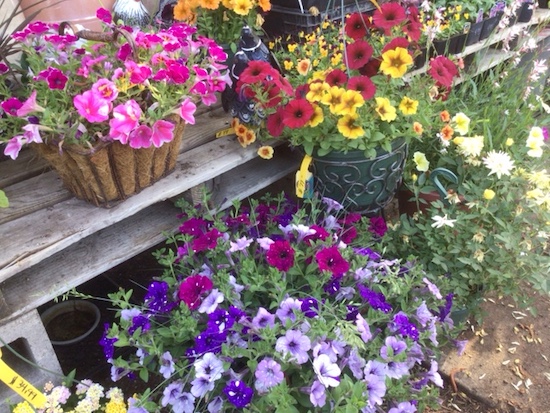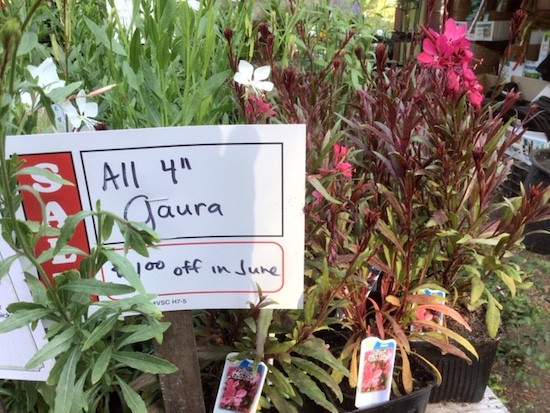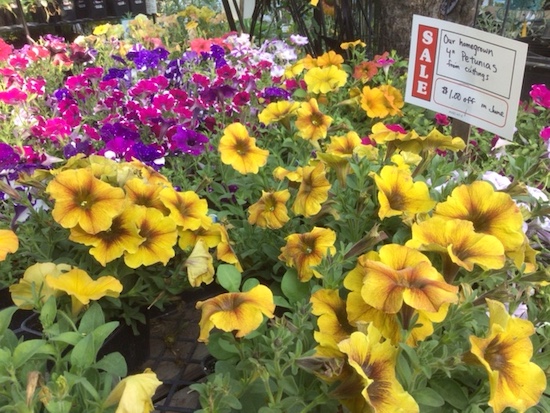
June is here, and the Summer Solstice is just 3 weeks away. I always find it a little hard to take that the days start getting shorter soon. However, on some of those scorching days we get, I can not wait for the sun to go down, so there is that. This time of year is when plants put on the most growth. If you saw our bare-root roses in February, you might be amazed at what they look like now. A lot of people ask when they see those sticks if they will bloom this year. The answer is yes, and they are putting on their first and often best show now.
Our hanging baskets were a big hit this year, as usual, especially around Mother’s Day. As cold as the spring was, I was afraid they would not be showy by May, but they really came on just in time. So did the 4-inch petunias and calibrochoas. The nursery is looking colorful and full right now. Some of the perennials like gaura and coreopsis are just beginning. Echinaceas and rudbeckias do not start to show color til July. There is still time to plant summer bulbs like glads, cannas, and dahlias, available now.

I am expecting the demand for vegetable starts to still be strong for a few more weeks, so we are planning on having a good selection for the time being. Just a reminder to plant some beneficial attracting flowers with or near your vegetables. Favorites are marigolds, alyssum, yarrow, nasturtiums, and any flowers with carrot-like foliage. Borage can help keep those tomato hornworms at bay. Chives will deter aphids. Plus, if you want to work or sit outside these evenings without getting eaten by mosquitos or bothered by flies, plant lavender and basil. For mosquitos, only use rosemary, marigolds, mint, lemon balm, lemongrass, and lemon verbena. Brush the plants to release the oils, and then brush your exposed skin with your hands. Geraniums are another all-around bug deterrent. People plant them in their windows to keep flies out of the house. Plant any of these natural bug chasers near your doors to keep pests out of the house.
Many of you were hit by those small beetles with shiny green backs. They are very attracted to phlox and daylilies. It turns out they are also very attracted to yellow, and the yellow sticky traps really helped. As a matter of fact, I always hang them up every year in my vegetable garden. They work for whitefly and other pests that might be thinking of doing a number on my tomatoes. Speaking of traps, we are expanding our assortment beyond whitefly, thrips, and apple moths to include cucumber beetles, peach tree borers, corn worms, and citrus leaf miners.

Did you know a lot of flowers are edible? Most know about the peppery nasturtiums or colorful violas you can add to dishes and desserts, but there are a lot more than just those two. Apple, citrus, and rose blossoms are some. Most herb flowers are edible, like chives, borage, chamomile, and lavender. You can eat peas, broccoli, squash, and bean flowers. Flowers like begonias, carnations, marigolds, calendula, hollyhocks, fuchsias, glass, and daylilies might surprise you. Hibiscus and honeysuckle probably won’t but mums and daisies? How about cornflowers? You can search the web for recipes using these edible beauties. Now even those of you who do not plant anything you can now eat can add a whole array of flowers to your pallet.
I ran across a couple of interesting articles, the gist of which I thought I would share. One was about a revolutionary CBD coating that keeps fruit fresh longer and will reduce food waste. Thai researchers have developed an invisible and edible coating using biodegradable polymers infused with CBD. Just one more star for the amazing multi-use but often maligned cannabis/hemp genus.

The other was about soil microbes that survive tough conditions helping reforestation efforts. You have probably heard that conditions on Earth are changing. Native trees are no longer thriving in their natural habitats. Research shows that saplings grown in soil microbes that have experienced drought, heat, and cold are more likely to survive their changing conditions. Let’s hear it for soil microbes! Just one more reason to use natural fertilizers as we sell and to grow organic, promoting healthy soil for a plant’s ability to withstand the changing conditions we find ourselves in today.
As we approach the hot days of summer and our yards and gardens demand for water increases, I will once again tout the benefits of mulch. Our hot sun just bakes bare earth. Please consider straw for your veggie beds and a more decorative mulch for your ornamentals. Plant trees around the yard so that no area is in all-day sun. Many of you are resorting to shade cloth overhead on your vegetable beds to protect your plants from the midday sun. They will still get plenty of light and sun to produce, just not all-day sun. We did get rain this year but conserving water is still a good thing. Mulch does that.
Speaking of getting plenty of rain, I have never seen the native yerba santa, lupine, and ceanothus bloom like it is now. Even the spring bloomers in our yards, like iris and lilacs, finally got enough water to put on a real show.
Keep stopping in to visit to see the next best flower shows coming soon. These will include dahlias, hibiscus, crepe myrtles, and more.

June Specials
- Overstocked Liner Pots Berries, Olives, etc. – 20% OFF
- $1.00 OFF our nursery-grown 4-inch pots of Gaura, Petunias, Calibrachoa, and 4D Osteos
- All Hydrangea Varieties- 20% OFF
- 10th bag FREE on all barks
